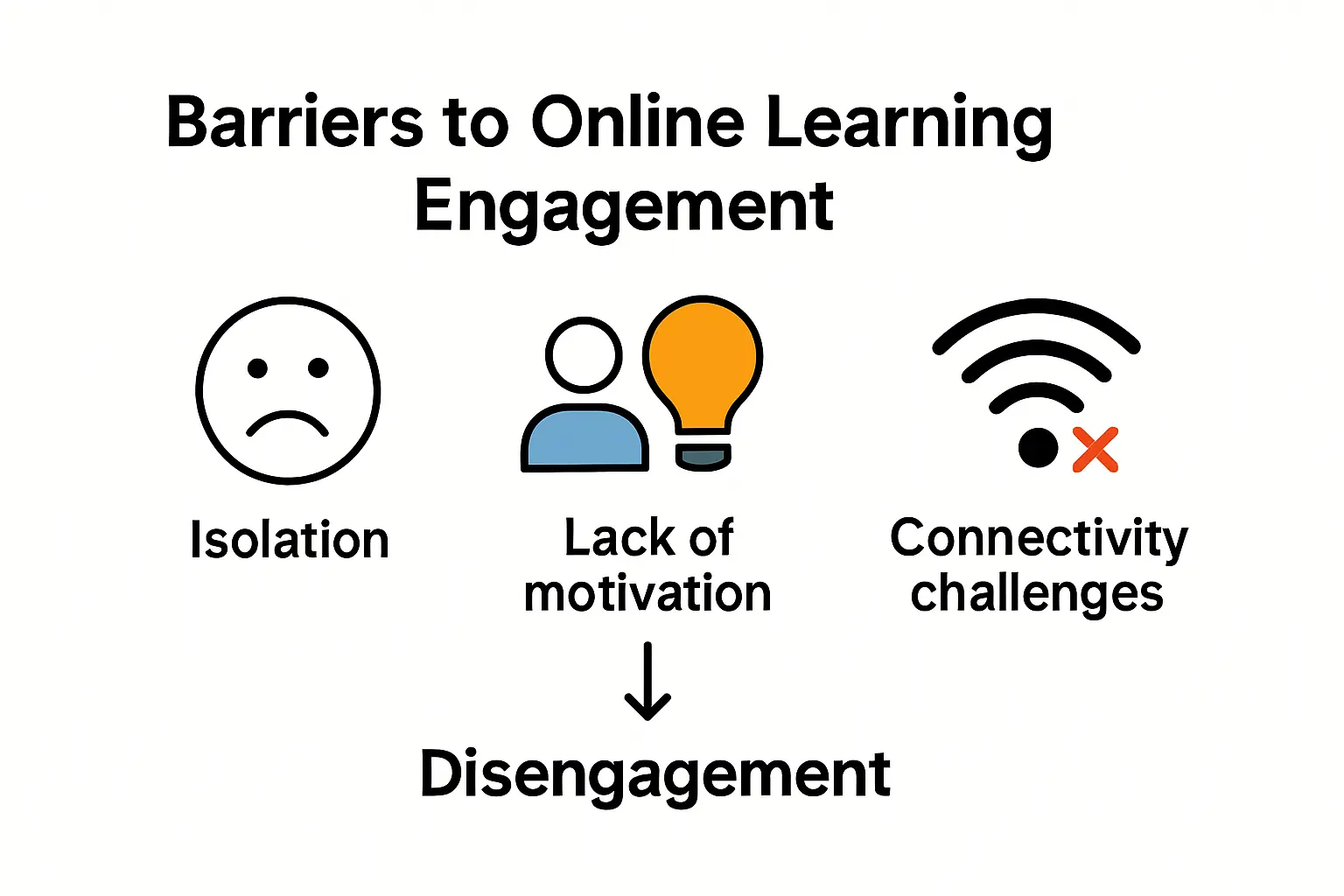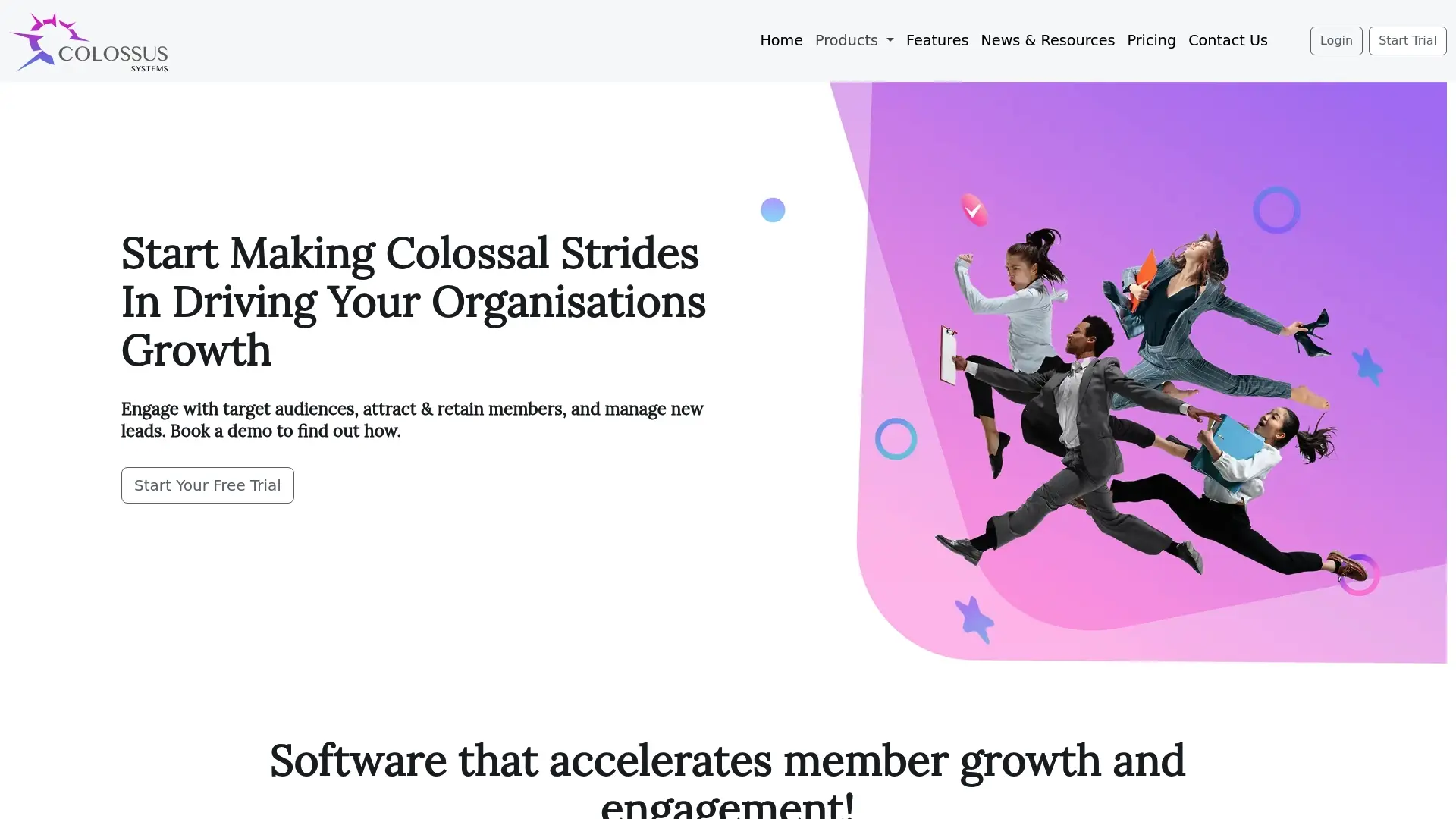Online Learning Engagement: Practical Strategies for Organisations

Online learning has become the backbone for organisations keen to develop their teams at scale. Yet despite all the webinars and fancy platforms, learner attention often drops faster than you might think. In fact, research shows that online learners report a sharp decline in motivation and engagement due to reduced interaction and support. You might expect the latest tech to solve this problem entirely, but genuine engagement still hinges on something quite unexpected. The real difference-maker is how you design the human experience behind the technology.
Table of Contents
- Understanding Online Learning Engagement Challenges
- Effective Strategies To Increase Participation
- Measuring And Sustaining Learner Engagement
Quick Summary
| Takeaway | Explanation |
|---|---|
| Address psychological barriers proactively | Understand that motivation can decline due to reduced interaction and support. Implement strategies to enhance learner confidence and connection. |
| Design interactive learning experiences | Create meaningful assignments that encourage collaboration and practical application to boost engagement levels among learners. |
| Leverage technology for engagement tracking | Use advanced analytics from learning management systems to monitor participation and quickly identify disengagement signals. |
| Gamify the learning process | Introduce elements like point systems and leaderboards to make learning more enjoyable and motivating for participants. |
| Implement continuous improvement strategies | Regularly collect feedback and adapt teaching methods to maintain relevance and engagement, ensuring a dynamic learning environment. |
Understanding Online Learning Engagement Challenges
Online learning engagement presents complex challenges for organisations seeking to create effective digital educational experiences. The shift towards virtual learning environments has exposed significant barriers that can dramatically impact learner participation and knowledge retention.
Psychological and Technical Barriers to Engagement
Learners encounter multiple obstacles that diminish their motivation and involvement in online educational programmes. Research from the National Center for Biotechnology Information reveals critical challenges including reduced interaction opportunities, difficulties in time management, and decreased intrinsic motivation. These psychological barriers are compounded by technical limitations that create additional friction in the learning process.
The lack of immediate support mechanisms and limited personal connection with instructors can significantly undermine learner confidence. Participants often report feeling isolated and disconnected, which directly impacts their willingness to actively participate in online learning activities. Technical challenges such as inconsistent internet connectivity, complex learning platforms, and insufficient digital literacy further exacerbate these engagement challenges.
The following table summarises the primary psychological and technical barriers to engagement in online learning as discussed in the article. Use this table to quickly identify the different categories of challenges and their key features.
| Category | Key Challenges | Examples/Explanations |
|---|---|---|
| Psychological | Reduced motivation, sense of isolation, lack of support | Decreased intrinsic motivation, feeling disconnected |
| Technical | Connectivity issues, complex platforms, insufficient digital literacy | Inconsistent internet, hard-to-use systems, tech difficulties |
| Interaction | Limited personal connection, reduced opportunities to participate | Fewer chances for direct communication with instructors |

Structural Limitations in Online Learning Design
Studies published in NCBI highlight negative correlations between stress sources and student engagement. Organisations must recognise that poorly designed online learning experiences can create substantial barriers to effective education. Prolonged synchronous sessions, inconsistent course formats, and minimal peer interaction contribute to learner disengagement.
The emergency remote teaching experiences during global disruptions exposed fundamental weaknesses in many organisations’ online learning strategies. Institutions discovered that simply transferring traditional classroom content into digital formats is insufficient. Successful online learning requires intentional design that addresses the unique psychological and technical needs of digital learners.
Strategic Approaches to Overcoming Engagement Challenges
Addressing online learning engagement demands a multifaceted approach. Organisations need to invest in comprehensive strategies that blend technological solutions with human-centric design principles. This involves creating interactive content, establishing clear communication channels, and developing support mechanisms that replicate the collaborative aspects of traditional learning environments.
Technology plays a crucial role, but it cannot replace thoughtful pedagogical design. Learn more about our comprehensive approach to virtual training that addresses these complex engagement challenges. By understanding the nuanced barriers learners face, organisations can develop more effective, empathetic online learning experiences that foster genuine knowledge acquisition and participant motivation.
The path to successful online learning engagement is not about replicating classroom experiences digitally, but reimagining educational interactions for a connected, technology-enabled world.
Effective Strategies to Increase Participation
Enhancing participation in online learning environments requires a strategic and multifaceted approach that addresses the unique challenges of digital education. Organisations must develop comprehensive methods that transform passive learning experiences into dynamic, interactive educational journeys.
Creating Interactive and Meaningful Learning Experiences
Research from the University of South Florida highlights the critical importance of developing clear, measurable learning objectives and establishing robust engagement frameworks. Meaningful assignments that connect directly to real-world applications can significantly boost learner motivation and participation.
Instructors can achieve this by designing tasks that encourage critical thinking, problem-solving, and practical application of knowledge. Interactive elements such as group discussions, collaborative projects, and scenario-based learning can transform passive content consumption into active knowledge construction. Learn more about enhancing member engagement through innovative learning approaches that prioritise participant interaction and meaningful content delivery.
Technological and Communication Strategies
Northern Illinois University recommends developing a comprehensive communication plan that establishes strong faculty presence and creates multiple interaction touchpoints. This involves providing frequent and interactive feedback, hosting virtual office hours, and utilising communication platforms that facilitate both synchronous and asynchronous interactions.
Technological solutions play a crucial role in increasing participation. This includes implementing user-friendly learning management systems, integrating interactive tools like live polling, breakout rooms, and real-time collaboration platforms. The goal is to reduce technical barriers and create seamless, intuitive learning experiences that encourage active participation.
Gamification and Community Building Approaches
Cambridge University Press suggests leveraging gamification techniques to increase learner motivation and engagement. By introducing elements such as point systems, achievement badges, leaderboards, and progressive challenges, organisations can transform learning into a more dynamic and enjoyable experience.
Community building is equally important in maintaining participant engagement. This involves creating structured opportunities for peer interaction, establishing clear communication norms, and fostering a supportive learning environment. Discussion forums, peer review activities, and collaborative projects can help combat the isolation often experienced in online learning settings.
Successful online learning participation is not about implementing a single strategy but creating a holistic ecosystem that supports, motivates, and empowers learners. By combining technological innovation, thoughtful design, and human-centric approaches, organisations can develop engaging online learning experiences that truly resonate with participants.

Measuring and Sustaining Learner Engagement
Measuring and sustaining learner engagement represents a critical challenge for organisations committed to delivering high-quality online learning experiences. Beyond initial participation, the true measure of success lies in developing robust mechanisms that continually assess, monitor, and enhance participant involvement throughout the learning journey.
Comprehensive Engagement Metrics and Assessment Frameworks
Research published in the National Center for Biotechnology Information reveals that learner engagement is a multidimensional construct influenced by psychological motivation, peer collaboration, cognitive problem-solving, and interaction dynamics. Organisations must develop holistic measurement approaches that capture these nuanced engagement elements.
Effective engagement measurement requires moving beyond traditional quantitative metrics like completion rates and time spent on platform. Advanced assessment frameworks should incorporate qualitative indicators such as discussion quality, peer interaction frequency, critical thinking demonstration, and self-directed learning behaviours. Learn more about improving member engagement strategies to understand the comprehensive approach needed for meaningful measurement.
Below is a table that compares key online learning engagement measurement methods and their focus areas, based on the article’s recommendations. This helps to clarify how each approach captures different aspects of learner participation.
| Measurement Approach | Focus Area | Example Metrics/Indicators |
|---|---|---|
| Quantitative Metrics | Platform activity | Completion rates, time spent on modules |
| Qualitative Metrics | Quality of participation | Discussion contributions, peer interaction frequency |
| Mixed/Advanced Assessment | Cognitive and behavioural engagement | Critical thinking shown, self-directed learning behaviours |
| Technology-Enabled Tracking | Real-time analytics and early intervention | Participation alerts, dashboard progress monitoring |
Technology-Enabled Engagement Tracking
Modern learning management systems offer sophisticated tools for tracking and analysing participant engagement. These platforms can generate detailed analytics that provide insights into individual and collective learning patterns. Key performance indicators might include participation rates in discussion forums, assignment submission consistency, interactive tool usage, and learner progression through course modules.
Real-time dashboards and predictive analytics enable organisations to identify potential disengagement early. By establishing automated alerts and intervention protocols, educational programmes can proactively support learners who demonstrate decreased participation or show signs of potential dropout.
Continuous Improvement and Adaptive Learning Strategies
The University of Illinois Center for Innovation in Teaching & Learning emphasizes the critical role of instructor presence and creating welcoming environments in sustaining learner engagement. Continuous improvement requires a cyclical approach of measurement, analysis, and strategic intervention.
Organisations should implement regular feedback mechanisms, including surveys, focus groups, and longitudinal studies that capture learner experiences and perceptions. This data can inform iterative improvements in course design, content delivery, and support structures. The goal is to create a responsive learning ecosystem that adapts to changing learner needs and technological capabilities.
Sustaining learner engagement is not a static process but a dynamic, ongoing commitment to understanding and responding to the evolving requirements of digital learning participants. By combining sophisticated measurement techniques, adaptive technologies, and a learner-centric approach, organisations can create online learning experiences that remain consistently compelling and valuable.
Frequently Asked Questions
What are the common barriers to engagement in online learning?
Online learning faces various barriers, including psychological obstacles like reduced motivation, feelings of isolation, and lack of support. Technical issues such as inconsistent internet connectivity and complex learning platforms also contribute to diminished engagement.
How can organisations enhance participation in online learning?
To boost participation, organisations can create interactive learning experiences that connect to real-world applications, implement user-friendly technology, and establish strong communication channels that foster collaboration among learners.
What role does gamification play in online learning engagement?
Gamification involves incorporating game-like elements, such as point systems and leaderboards, into learning experiences. This approach can significantly increase learner motivation and make education more enjoyable, helping to maintain participant engagement.
How can organisations measure learner engagement effectively?
Effective measurement of learner engagement can go beyond tracking completion rates and time spent on platforms. Organisations should utilise a combination of quantitative metrics, qualitative participation indicators, and advanced assessment frameworks to gain a comprehensive understanding of learner involvement.
Transform Online Learning Engagement into Tangible Results with Colossus Systems
Are you finding it difficult to maintain learner motivation, drive participation, or track engagement in your organisation’s digital learning programmes? As highlighted in our article, common challenges such as reduced interaction, poor course design, and lack of real-time analytics can lead to a sharp decline in online learning engagement. Membership-based organisations often struggle to provide meaningful connections and streamlined support that keep learners actively involved.

Take your learning engagement strategies to the next level. With Colossus Systems, you can easily create interactive virtual training, monitor real-time participation, and foster engaging communities across your membership base. Our unified SaaS platform blends customisable training modules, advanced analytics, and targeted communication tools under one roof. Avoid losing attention and momentum in your programmes—start building a connected, motivated, and high-performing membership community today. Explore how our solutions help you increase learner engagement and streamline management at Colossus Systems.
Recommended
- Virtual Training Best Practices for Membership Groups 2025|CS
- Improving Member Engagement: Proven Strategies for 2025|CS
- LMS and EMS for training providers and educational institutions|CS
- Essential Guide to Onboarding New Members Successfully|CS
- Effective Online Collaboration for Aviation Professionals
- Teaching Art Online in South Africa: Guide for 2025 - Blue Pea Online Market